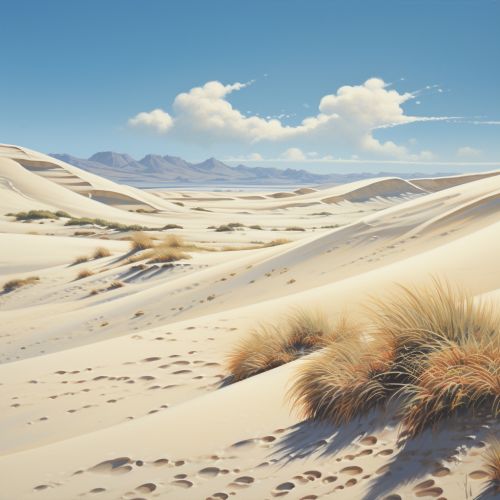Transverse dunes
Introduction
Transverse dunes are a common type of aeolian landform that are formed by the action of wind on loose, unconsolidated material such as sand. They are characterized by their elongated, ridge-like shape that runs perpendicular to the prevailing wind direction.


Formation
The formation of transverse dunes begins with the deposition of sand particles by wind. This process, known as aeolian deposition, occurs when the wind's velocity decreases, causing it to drop the sand particles it was carrying. Over time, these particles accumulate to form small mounds known as ripples. As more and more sand is deposited, these ripples grow in size and eventually form dunes.
Transverse dunes specifically form in environments where the wind direction is relatively constant and the supply of sand is abundant. The wind causes the sand to pile up into ridges that run perpendicular to the wind direction. The side of the dune that faces the wind, known as the windward side, is typically a gentle slope, while the side facing away from the wind, known as the leeward side, is typically a steep slope. This is due to the differing rates of sand deposition and erosion on the two sides of the dune.
Characteristics
Transverse dunes are typically straight or slightly sinuous in shape, and can vary greatly in size. The height of these dunes can range from less than a meter to several tens of meters, and their width can range from a few meters to several hundreds of meters. The length of transverse dunes, however, can extend for many kilometers.
One of the key characteristics of transverse dunes is their uniformity. Due to the constant wind direction, the dunes in a transverse dune field typically have a uniform height and spacing. This uniformity, combined with their large scale, can make transverse dune fields some of the most visually striking aeolian landforms.
Another important characteristic of transverse dunes is their mobility. These dunes are constantly shifting and changing shape in response to changes in wind direction and speed. This mobility can lead to the formation of complex dune patterns, as dunes can merge, split, or be buried by other dunes.
Types of Transverse Dunes
There are several types of transverse dunes, each with their own unique characteristics. These include barchan dunes, parabolic dunes, and seif dunes.
Barchan dunes are crescent-shaped dunes that form in areas with limited sand supply and a constant wind direction. The horns of the crescent point downwind, and the dune moves in the direction of the wind.
Parabolic dunes, on the other hand, are U-shaped dunes that form in areas with a moderate sand supply and strong winds. The arms of the U point upwind, and the dune moves in the direction opposite to the wind.
Seif dunes are long, narrow dunes that form in areas with a large sand supply and variable wind directions. These dunes are aligned with the average wind direction, and their long axis is parallel to the resultant sand transport direction.
Distribution
Transverse dunes can be found in a variety of environments around the world, from coastal areas to deserts. They are particularly common in arid regions, where the lack of vegetation allows the wind to freely move the sand.
Some of the most famous examples of transverse dunes include the Sahara Desert, where they form vast dune fields, and the Namib Desert, where they form some of the tallest dunes in the world. Transverse dunes can also be found in many other parts of the world, including North America, Asia, and Australia.
Impact on Humans
Transverse dunes can have both positive and negative impacts on human activities. On one hand, they can pose challenges for infrastructure development and transportation, as their constant movement can bury roads and buildings. On the other hand, they can also serve as natural barriers against wind erosion and sand movement, protecting agricultural lands and human settlements.
In addition, transverse dunes are important sites for scientific research. They provide valuable insights into wind patterns, climate change, and the geological history of an area. They are also popular destinations for tourism, offering unique landscapes and recreational opportunities such as sandboarding and dune bashing.
